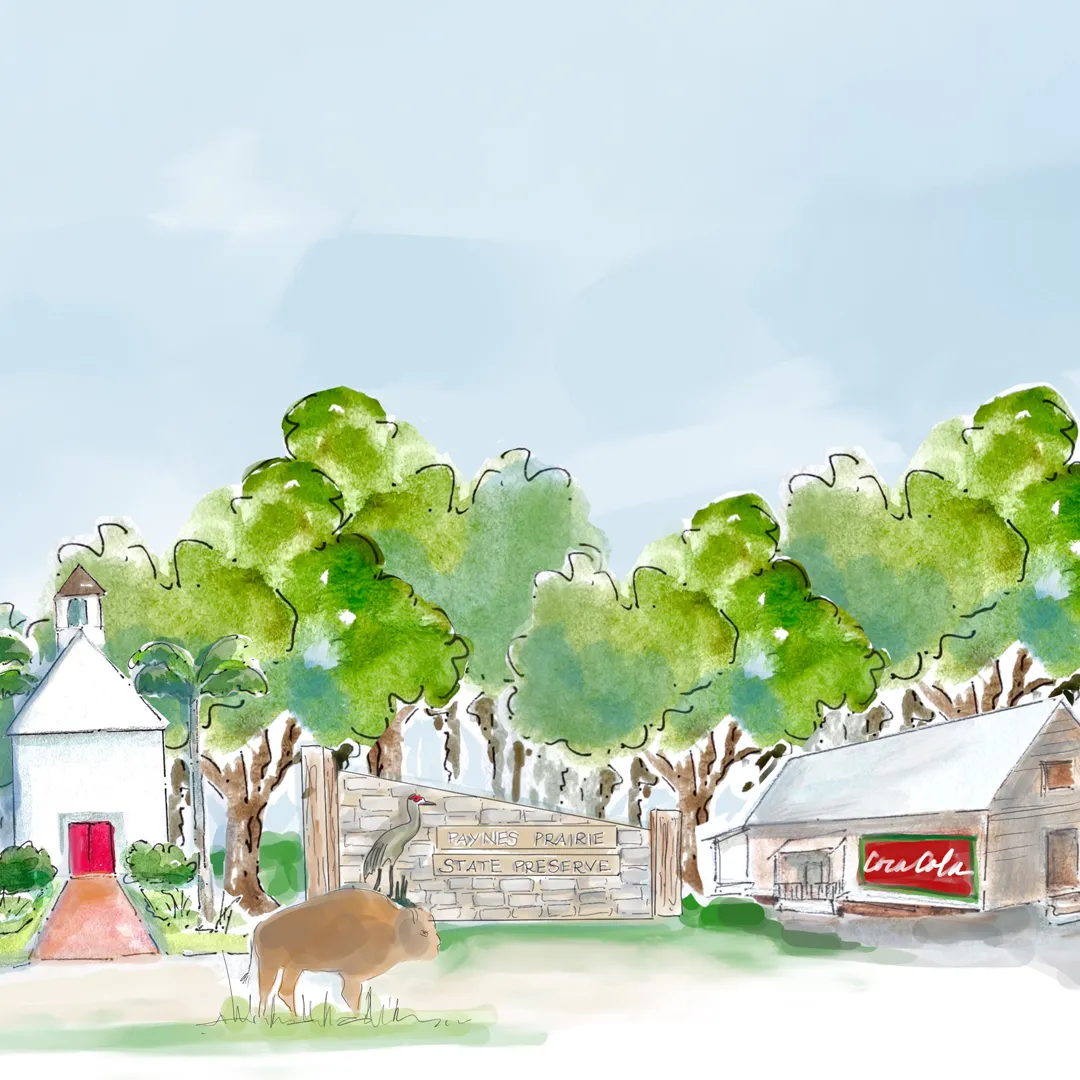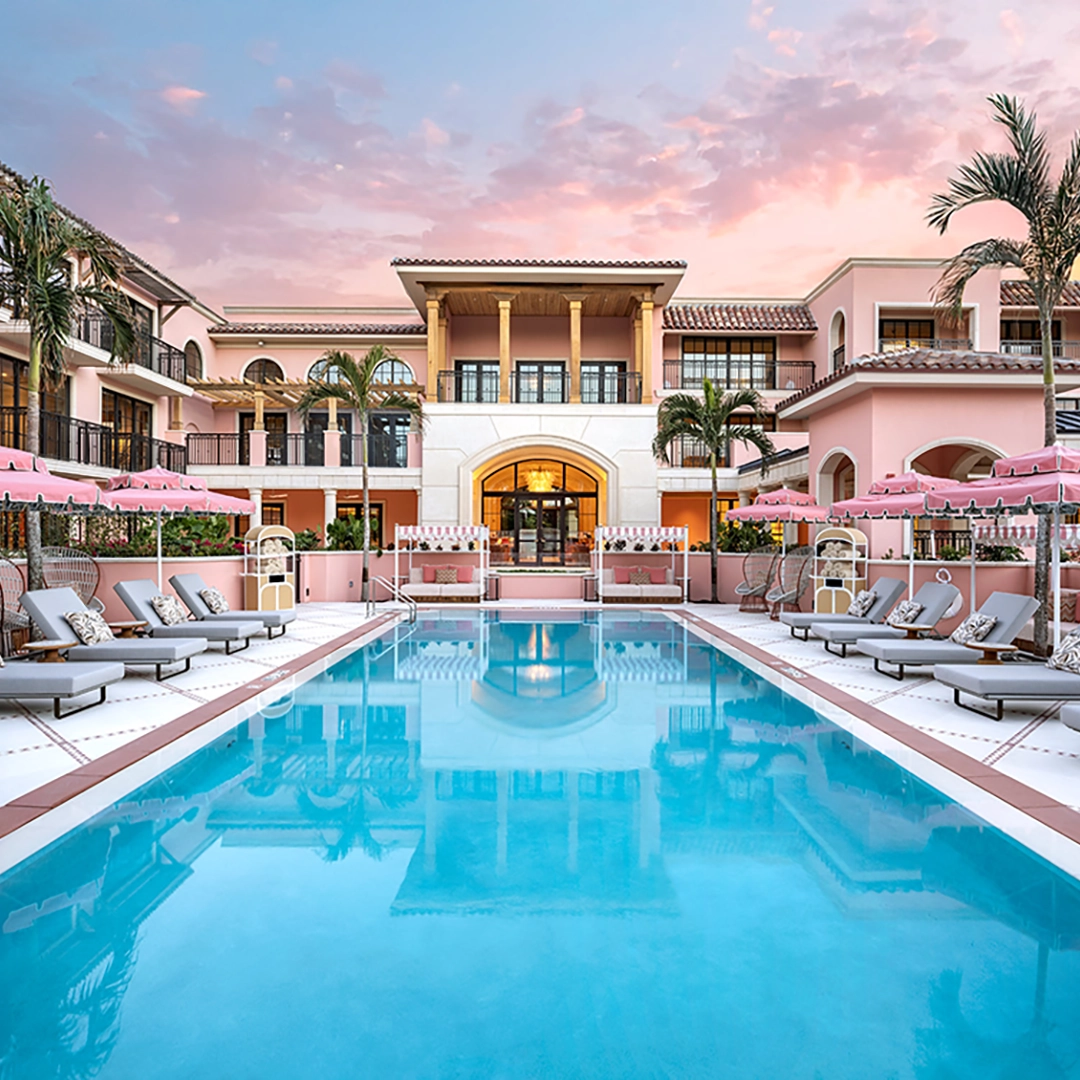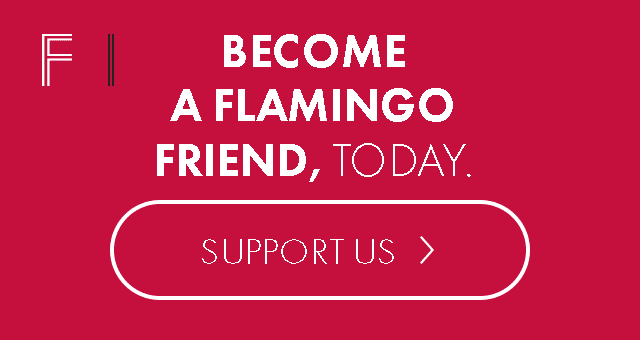by | November 24, 2020
Mayberry in Limbo: What Has COVID-19 Done to Florida’s Small Towns?
People have been singing a swan song for our country’s small towns for years, so what does the pandemic mean for them?
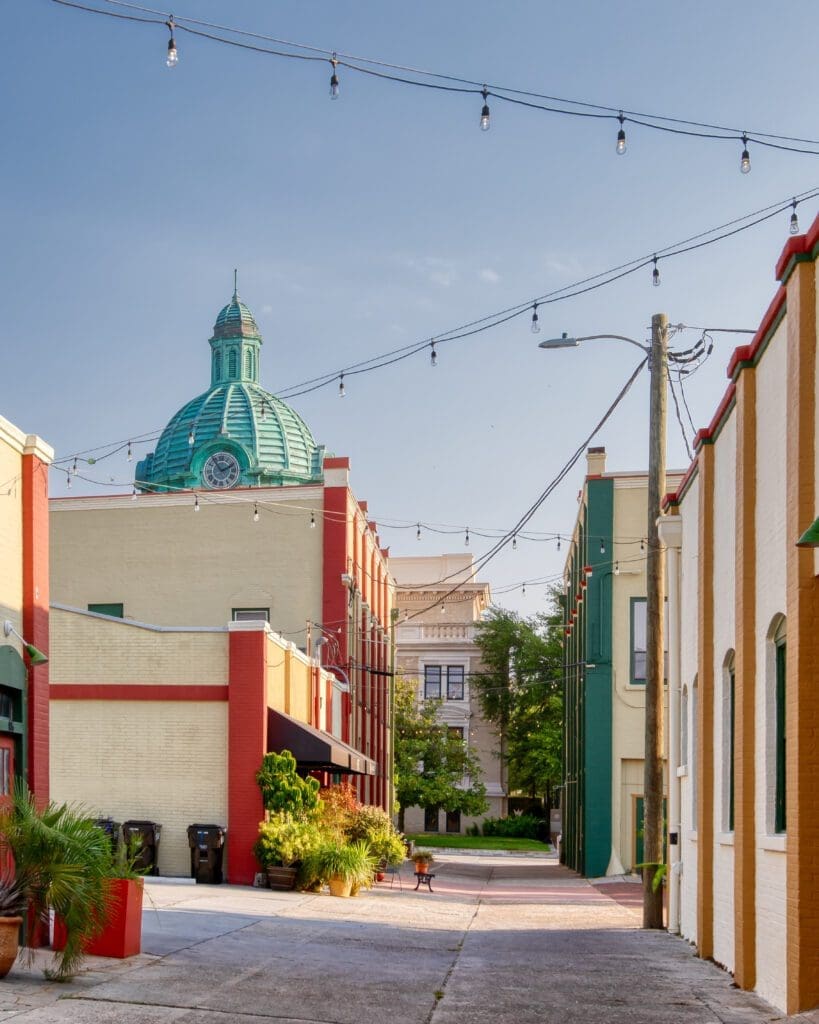
I can tell the lunch rush is in full swing from the chorus of laughter and chatter bouncing off the high, ornate white ceiling. Stepping off of Brooksville’s sleepy Main Street into this bustling little bistro, the difference in volume is jarring. Swirling amidst the organized chaos is Catherine Reeves. She’s officially the owner of The Bistro, but Reeves also side hustles as a waitress, food runner, hostess and busser. She’s wrapping up a takeout order as I make myself at home on a nearby barstool.
“Is there ketchup in the bag? You know we like ketchup with our fries,” an employee from the knitting shop a few doors down says.
“Oh, just take the whole bottle. Keep it in your fridge,” Reeves snorts, handing her a full bottle of Heinz with her Styrofoam container. “Local business owner,” she says to me. “Never gets enough ketchup with her fries.” Reeves throws a look over her shoulder as if to say, You know how it is.
And she’s right. I know all too well how it is because I grew up in DeLand, a town that looked a lot like Brooksville not too long ago. I worked at a frozen yogurt shop on the main strip in high school, where we traded big cups of white chocolate mousse for chicken gyros from the Greek restaurant down the block. By definition, DeLand is Small Town, USA, boasting a population under 50,000. Although we’ve added some mainstream assets to the city over the past few years—people went berserk when Chick-fil-A arrived in 2017—the town has maintained its intimate feel. Every trip to Publix is a high school reunion, and you’d better not smack talk anybody in public, because their mother’s sister’s best friend is probably eating at the table next to yours.
In the Sunshine State, this is where the final remnants of Old Florida hide, beneath aging oak trees, on peeling white porches of Victorian homes and along historic downtown streets in cities most can’t pinpoint on a map. For years, economists, politicians and many a news outlet have doomed these small towns to a slow, sorry death. Millennials don’t want to live there, companies don’t want to headquarter there and freeways plow right through them—or at least that’s been the narrative. And now, add COVID-19 to their list of grievances. Given the already precarious position of many small-town economies across Florida, it seemed coronavirus might be the final verse of their swan song, but rural America hopes the virus might be the unexpected kindling for a long-awaited rebirth.
THE HEART OF OLD FLORIDA
Despite the doom-and-gloom stories that surround it, rural America isn’t exactly the ghost town it’s painted out to be. There’s a reason that idyllic images of front porch chats and small-town charm still resonate, and it’s because nearly half of Americans still live in proverbial Mayberry. About 76 percent of U.S. towns and cities are home to fewer than 5,000 people, according to a 2019 estimate by the U.S. Census Bureau. Those are little blips on the map like Jasper, Wauchula and Sopchoppy: towns you drive through but rarely to—and probably can’t pronounce. These quaint burgs are often held together by historic main streets lined with mom-and-pop shops, where the heartbeat of Old Florida thumps on.
While cities with fewer than 5,000 people have been shrinking in the Northeast and Midwest, they’ve actually been experiencing modest growth in the South for the past 10 years, the U.S. Census Bureau reports. Here in Florida, where people still speak of a “slower pace of life” and the old-school allure of a tight-knit community, these humble municipalities are an attractive respite.

In Brooksville, just about an hour’s drive north of Tampa, the stairway of the 1913 Hernando County Courthouse, flanked by neoclassical columns, serves as the heart of the historic downtown district. Catty-corner to the courthouse sits the other Brooksville anchor: Main Street Eatery. If the green fabric tatters hanging from the weathered awning don’t give away its age, then the banner boasting “Brooksville’s Best Cuban Sandwich for 30 Years” certainly does.
I came here to see for myself what the pandemic was doing to these hamlets so many have said to be vanishing. Fortunately for me, word spreads fast around Brooksville, so by the time I grabbed a latte from the local coffee shop, everybody knew there was a reporter in town.
Compared to Main Street Eatery, The Bistro is a newbie on the scene. Owner Catherine Reeves moved to Brooksville from Pinellas in 2004. She was itching for some land and a downtown she could fall in love with. The moment she saw the courthouse, she was sold. “‘Oh my gosh, this is like Mayberry,’ I said when we first came up. But I love it because it is,” she tells me.
Part of small-town America’s lasting charm is the enduring belief that it can still be fertile ground for the American dream. A place where people with big aspirations and humble means can open their bakeries, fitness studios, barber shops and boutiques.
For Reeves, the American dream was never rooted in being a business owner. She opened The Bistro in 2014 to help teach her daughter Emily, who has high-functioning autism, life skills.
“Of course, where is she today when I need her, right?” Reeves quips, motioning at the farm tables stuffed with locals hungry for lunch. “She’s at the knitting shop down the street!”
Oh my gosh, this is like Mayberry, I said when we first came up. But I love it because it is.
— Catherine Reeves
Over the years, The Bistro has become quite the family affair. Reeves’s son works as a chef. Her daughter-in-law is a waitress. Emily has gone from trainee to waitress, and Reeves is now woven into the fabric of the downtown that first convinced her to become a Brooksvillean. Large black-and-white photographs of the livery-stable-turned-lumber mill and the old Sinclair Service Station hang on the vintage brick walls: a fitting homage to the history that The Bistro is now a part of.
Like the photographs suggest, the fabric of Brooksville has been slowly changing, stitch by stitch. When The Bistro first opened its doors, it was one of the only businesses downtown that wasn’t a court reporter, lawyer or insurance firm. Sure, Brooksville had the foundations of a strong downtown: beautiful historic buildings, a few well-loved staples and a tight-knit community. But it was brimming with untapped potential—a scenario many small towns across the state can relate to. Strolling the brick sidewalks today, I see that professional services still take up a bulk of the downtown leases, but now they mingle with bakeries, home decor workshops, vintage furniture stores and health food cafes.
The evolution of Main Street in Brooksville has been slower than hoped, but Reeves, like so many of the other business owners downtown, believes the place has the makings of a modern-day Stars Hollow, the picturesque setting of Gilmore Girls. Even beyond Brooksville, local leaders are hopeful that the COVID-19 pandemic might be an unexpected ally for towns like these across the country.

“ONE OF MY LOWER DAYS”
Reeves didn’t see the opportunities thrust upon her by the pandemic at first. How could she when every other phone call was a cancellation? About 40 percent of her business is catering, so when weddings, banquets, galas and all other functions suddenly became a public health threat, almost half of The Bistro’s business dried up overnight.
“I mean the one week it was just call after call was like, ‘No, no, no. We’re not having this,’” Reeves recalls, twisting her beaded necklace. “That was one of my lower days.”
For a while, it was a waiting game. While megachains ran deals boasting $10 pizzas and gallons of margaritas, The Bistro was forced to lay off much of its staff.
“We stayed open during the day, and people would call in, but honestly, we’re not really a takeout place. I find a lot of people come here for our atmosphere,” she says. That’s what happens when you become a community gathering place. People flock to The Bistro for good conversation with good friends. The food is just what gets them all to the table.

A few doors down, the Teal Plank Workshop, a DIY home decor classroom, was thinking fast to come up with a new business model during the pandemic. Charlene Giles had just bought the company in October and moved into a spacious Main Street space right across the street from the historic courthouse in the hopes of increasing visibility. It was the perfect spot: well-trafficked and in the heart of all the action. The April Blueberry Festival would fill Main Street with tourists, and the Christmas festival would attract thousands to her front door. Come April, the Blueberry Festival was canceled, and this year’s holiday lights likely won’t attract the same crowds they normally do.
“It forced us to be very creative,” Giles says. Instead of hosting team-building workshops and private parties in the studio, the Teal Plank began offering to-go projects and curbside pickup. Those who were itching to fill their quarantine days with a crafty DIY could order all the materials online, pick them up and then follow along with a tutorial online. The to-go orders took off, but as the pandemic stretched on, Giles had to brainstorm other innovative ways to keep her business running. The studio started shipping DIY kits nationwide, even sending a project all the way to Seattle. “We had good and bad times during COVID, but we just had to keep rethinking and do different things,” Giles says.
Creativity has been key to the survival of small businesses and historic downtowns all around the state. In my hometown of DeLand, the city mobilized quickly once the pandemic hit to set up a vast curbside pickup program throughout downtown. By the end of March, businesses hard-hit by the virus had 14 designated parking spots for patrons to use when swinging by to pick up to-go orders.
Trilogy Coffee Roasting Co., a well-loved addition to downtown DeLand opened by Clay and Michelle Cass in 2016, wound up launching their new food program early thanks to a push from coronavirus. The launch had been in the works for a while, but when business slowed, the coffeehouse partnered with a food truck owner who had more free time on his hands to begin serving seasonal fruit bowls, freshly baked pastries and organic quinoa pudding. Although the physical cafe was able to remain open throughout the pandemic, Trilogy also significantly expanded its reach with a mobile app to capture curbside orders and offset the decrease in foot traffic.
“The biggest thing we did at the beginning was to just rethink how we navigate this new landscape and do it in a safe way but that it’s still prosperous for us, for our employees, so they still have a job and so our community still has some little slice of normalcy,” Michelle Cass says. But even with their quick pivoting and new offerings, they weren’t immune to the fallout of coronavirus. The cafe had to substantially cut the hours of its staff—although they all stayed on payroll—and suffered a significant blow to its wholesale business.
More than 260 miles away in the Panhandle, Quincy, a town of about 7,000, is struggling to regain its footing after losing businesses that were downtown staples.
“I really came in when I thought Quincy was in a low,” says Penny O’Connell, executive director of Quincy Main Street. “It’s in a lower low than it was.”
The town lost Damfino’s, a local market and eatery that anchored the downtown square, and Fringe, a hair styling salon. Several other locally owned businesses that drew people to the charming nine-block downtown district closed their doors temporarily but are expected to recover, O’Connell says. During the pandemic, Quincy Main Street partnered with small business owners to help them apply for Paycheck Protection Program loans, small business grants and other types of financial support to help them survive, but for some, the help came too late or not at all. O’Connell doesn’t believe that coronavirus will strangle Quincy’s potential. Just like the locals in Brooksville, she holds onto hope that Quincy is on the cusp of a turnaround.
“You have to start where you can start, and we’re still at humble beginnings. But we’ll get there; we’ll get it moving again,” she says.
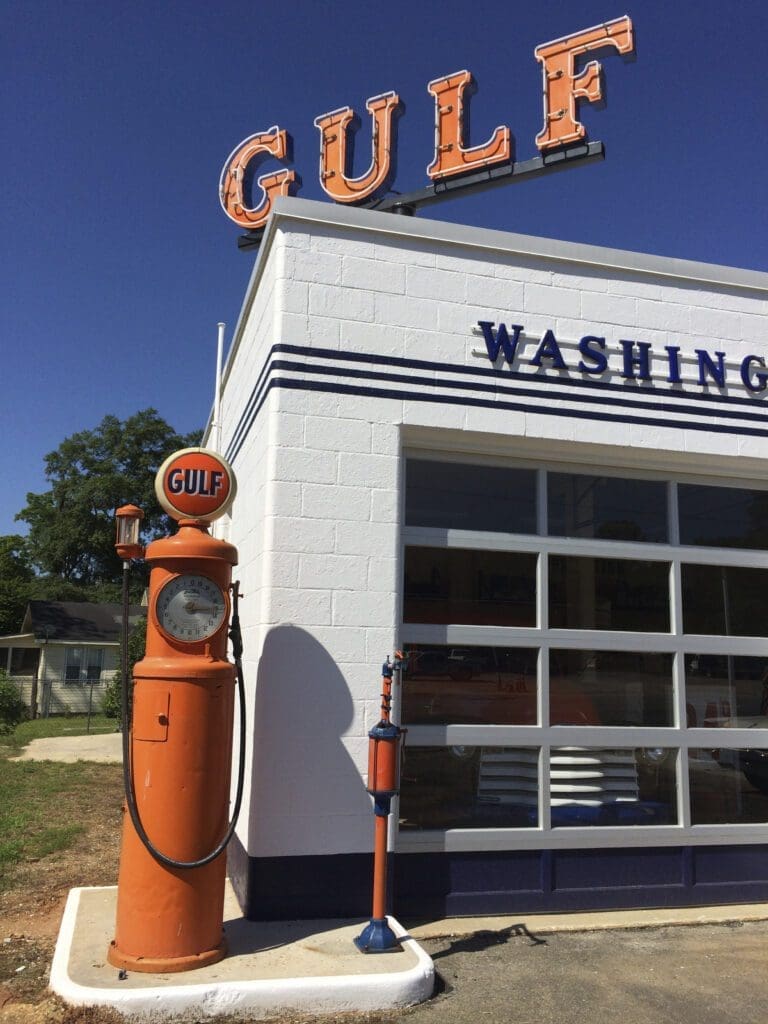
WHERE EVERYBODY KNOWS EVERYBODY
Quincy’s struggles aren’t unique. There are inherent challenges that come with being a small town, says Tim Parsons, director of Florida’s Division of Historical Resources. As director, Parsons also oversees Florida Main Street, a technical assistance program that helps cities breathe new life into their historic downtown areas and spur economic growth.
“The one thing that I’ve noticed that all these towns tend to struggle with [is] financial stability,” Parsons says. These places don’t enjoy the same tax revenue or financial resources that cities like Miami or Orlando do, so they can’t throw money at their problems the same way that urban areas can.
You have to start where you can start, and we’re still at humble beginnings. But we’ll get there.
— Penny O’Connell
To make up for the lack of tax revenue, forming partnerships is critical to fill in the gaps. Lucky for rural America, this usually comes naturally. In fact, it’s sort of these towns’ secret superpower.
“There’s oftentimes a more organic connection between, for example, the people that own businesses and the people that are on the city commission or the county commission or other local boards that can interact with and support the main street,” he says. The close relationships that give a rural community its Mayberry feel can also help solve their most pressing economic troubles. For cities like DeLand that are able to consistently rely on partnerships between business owners, the Main Street Association and the city commission, problems can be tackled quickly and effectively, with support at every level. But as anyone who’s ever lived in a small town can tell you, close quarters also often mean drama spreads fast, and if the drama infiltrates government or nonprofits critical to the support of downtown, it can make healthy partnerships difficult.
This is the battle Brooksville finds itself in. While local business owners and Brooksville Main Street often collaborate to promote downtown shops on social media and brainstorm new ways to revitalize the district with new murals and walking trails, the Brooksville City Council hasn’t always been on the same team. The council even voted to defund Brooksville Main Street in July but later reconsidered the decision after public pushback, ultimately granting 50 percent funding. The messy politics have discouraged some businesses from moving into the downtown strip, including Crank Works Bicycles, owned by Patricia Laird. Laird recently made the leap to expand her business in a strip mall outside of the downtown area because she didn’t want to get involved in the headache-inducing politics that come with a lease in the heart of Brooksville.
“The sad thing is, you get younger blood—like I would consider myself newer blood—and new ideas and new ways of trying to move things forward and improve things, and it’s discouraged,” Laird says.
But it’s often this younger blood that can infuse small towns with new life. Historic downtowns thrive when they’re used as playgrounds by locals with an entrepreneurial spirit. When two best friends converted the rustic 1920s parking garage in downtown DeLand into the city’s first microbrewery, the economic benefits rippled throughout the downtown district. Over time, the microbrewery has been followed by a slew of new businesses, from Trilogy Coffee Roasting Co. to Chica’s Cuban Cafe.
This is the vision of communities like DeLand across the state. Penny O’Connell of Quincy Main Street believes that cultivating a strong downtown is the kickstart the rest of Quincy needs.
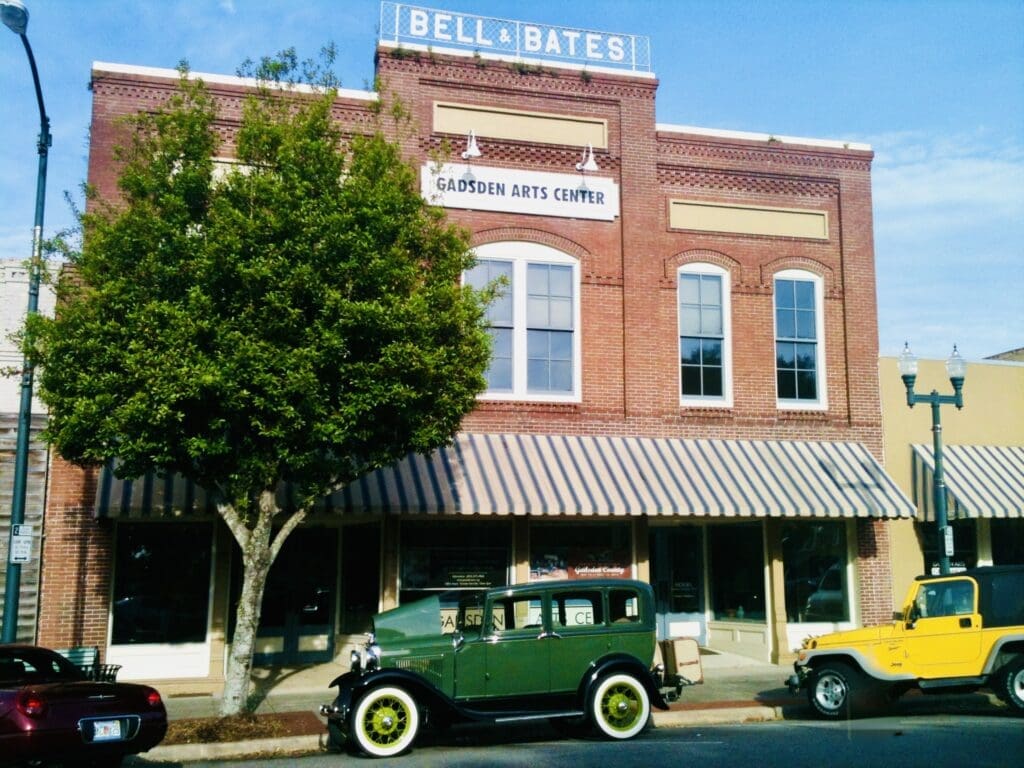
“If you can get that nine blocks revived, it will spread north and south, east and west from those nine blocks,” she says. “The whole county will improve if we can get our downtown going. Money will spread.”
Not only will revitalizing these historic downtowns keep the greater area alive economically, but it preserves that slice of Old Florida so many are nostalgic for, says Florida Main Street director Tim Parsons. “What it really is, is a method for helping preserve the character of our city and the heart of our cities, and really, in a lot of ways, the heart of our state.”
A MAYBERRY REVIVAL
Despite widespread cancellations, mounting financial pressures and pervasive uncertainty, Florida’s small towns are flexing their resiliency. Lease occupancy has increased in Brooksville since the beginning of the year. Back in January, the downtown district had 20 of its 135 leases vacant, but by mid-October, that number fell to 16 vacancies, says Natalie Kahler, executive director of Brooksville Main Street.
“I think the good thing to come out of this pandemic is that people have become very focused, at least in my experience, on supporting their small businesses in ways that they maybe haven’t before,” Kahler says. She sees evidence of this in the new knitting shop that moved into a vacancy along Main Street in May. Two years ago, Kahler never would have pictured a boutique knitting shop thriving in downtown Brooksville, but when I entered the faded brick storefront that September morning, the wooden dining table was full of women picking out yarn, stitching together projects and catching up with one another.
I think the good thing to come out of this pandemic is that people have become very focused, at least in my experience, on supporting their small businesses in ways that they maybe haven’t before.
— Natalie Kahler
“They have done amazingly well, and it’s because part of what happened in the pandemic is people’s drive for finding a place of community,” Kahler says. “So when you go in there, you have a new little network and a new little home and a new place for people to connect in a very safe way.”
The ache for human connection is more pronounced than ever as our society is learning to live in a world where Zoom calls and small, socially distant gatherings are meant to substitute for a hug from just the right person or backyard barbecues with everyone on the block. And small towns are hoping to capitalize on that.
“We were all forced to evaluate how we were spending our time, and what we were doing with our life,” Kahler says. “So now everybody has the chance to reinvent their life and their schedule.”
Towns like Brooksville are hoping that the rise of telework and this reassessment of priorities will attract new residents to their city, and early data suggests there’s reason to be optimistic. A study conducted by MYMOVE using United State Postal Service data found that nearly 16 million people moved during the first six months of the coronavirus outbreak, most of them relocating from densely populated urban areas to nearby suburbs or smaller towns. The reasons behind this urban flight are numerous, according to the Pew Research Center. Many people want to live somewhere that’s less populated to reduce the risk of contracting the virus. Others moved places where the cost of living is lower to accommodate job loss or financial hardship, and some just wanted to be closer to family during the chaos.

Small towns check nearly every box—fewer people, cheaper living and more space to spread out—but it’s still too early to tell if the population shift will be permanent. The USPS saw a 27 percent increase in temporary change-of-address requests this year compared to last, with the biggest spikes occurring in March and April. But these requests are just that: temporary. And even if these towns do see an influx of residents, the newcomers will bring a host of challenges as well as profits. A rush of new people could be a catalyst for virus outbreaks, straining public health infrastructure that already tends to be much less robust in small towns compared to their urban neighbors.
Regardless of whether or not the COVID-19 population shift is permanent, it’s clear Florida’s small town woes won’t be entirely solved by a virus-prompted population boom. For these towns to not only survive, but thrive in today’s society, they need dreamers, risk-takers and leaders.
As I snap a few final photos of the vintage streetlights guarding the Main Street storefronts, I notice a banner clinking against a metal fence. Yellow words over a big red heart read “Believe in Brooksville.” One thing is for sure, Brooksville has believers.


